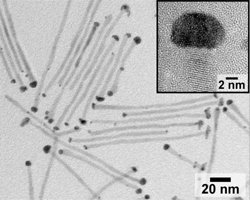 The inherently high surface area of bimetallic nanoparticles makes them especially attractive materials for heterogeneous catalysis. The ability to selectively grow these and other types of nanoparticles on a desired surface is ideal for the fabrication of higher-order nanoscale architectures. However, the growth mechanism for bimetallic nanoparticles on a surface is expected to be quite different than that for free particles in solution. The altered growth process can lead to modulations in stoichiometry, elemental homogeneity, and surface structure, all of which can profoundly affect the catalytic or magnetic properties of the bimetallic nanoparticles. Now, researchers have experimentally observed these subtle structural differences through x-ray absorption spectroscopic studies at ALS Beamline 10.3.2. The results illustrate how directed nanoparticle growth on specific surfaces can lead to hybrid nanomaterials with a structurally different bimetallic component than its unhybridized counterpart.
The inherently high surface area of bimetallic nanoparticles makes them especially attractive materials for heterogeneous catalysis. The ability to selectively grow these and other types of nanoparticles on a desired surface is ideal for the fabrication of higher-order nanoscale architectures. However, the growth mechanism for bimetallic nanoparticles on a surface is expected to be quite different than that for free particles in solution. The altered growth process can lead to modulations in stoichiometry, elemental homogeneity, and surface structure, all of which can profoundly affect the catalytic or magnetic properties of the bimetallic nanoparticles. Now, researchers have experimentally observed these subtle structural differences through x-ray absorption spectroscopic studies at ALS Beamline 10.3.2. The results illustrate how directed nanoparticle growth on specific surfaces can lead to hybrid nanomaterials with a structurally different bimetallic component than its unhybridized counterpart.
Transmission electron microscopy (TEM) image of PtCo–CdS hybrid nanostructures, with high-resolution TEM inset.
Platinum-based bimetallic alloys (such as PtNi, PtCo, PtRu, etc.) have been studied in the bulk form for some time and have been found to exhibit vastly different properties than their individual constituent metals. This is particularly true in catalysis, where Pt-based bimetallic alloys have shown enhanced oxygen reduction activity or accelerated rates of alkene hydrogenation. The catalytic activity of these materials is dependent on the surface structure, and although bimetallic materials are rather well understood in the bulk form, the picture becomes less clear when these materials reach nanoscale dimensions.
Additionally, the ability to directly integrate a metallic nanoparticle with a semiconductor structure is highly desirable. The formation of such hierarchical hybrid nanostructures can allow for new properties and applications that are not available with just the individual components. However, until recently, it was unclear what effect surface-directed nanoparticle growth would have on the structure of a bimetallic nanoparticle, particularly on its surface composition.
Using a novel, recently developed synthesis technique, the researchers fabricated hybrid nanostructures consisting of cadmium sulfide (CdS) nanorods with PtCo nanoparticles grown selectively on the nanorod tips. The structure of these hybrid nanomaterials was compared to free-standing PtCo nanoparticles synthesized by conventional solution-phase methods, using a combination of x-ray absorption near-edge structure (XANES) and extended x-ray absorption fine structure (EXAFS) spectroscopies at the Pt L3- and Co K-edges and x-ray diffraction measurements. Because...
pcos pregnancy success stories academic success secret of my success cast success in life leapfrog leapstart preschool success success platform pacific college empty sac at 8 weeks success stories success spelling medmen lake success center for success and independence plan b success rate during ovulation success rate of cervical epidural steroid injection there is no elevator to success lake success shopping center reproductive success how i raised myself from failure to success in selling what is success diversifying into new businesses can be considered a success only if it success in chinese meru the success the key to success tarkov ralph waldo emerson success poem best morning routine for success writing for success mantras for success success pictures success pronunciation vbac success calculator success quotes ivf success stories increase implantation success deviated septum surgery success rate gastric sleeve revision success rate bariatric surgery success rates hip labral tear surgery success rate measure of success success inspirational words coming off antidepressants success stories threatened miscarriage success stories my 600 lb life success stories success vision paducah ky palmers skin success fade cream dj khaled suffering from success vbac success calculator our lady of good success novena success academy videos gastric sleeve revision success rate success criterias success essay suited for success sweet smell of success noom success stories success academy charter schools was the new deal a success how to spell success lake success zip code seven spiritual laws of success mission success open heart surgery success rate african american quotes about success slug success give and take a revolutionary approach to success synonym for success ovulation pain and pregnancy success gastric bypass revision success rate motivational quotes for work success salon success
 I mean, the construction is completely different, the electrolyte is different, the substrate is different. It's still a "battery," though, so it still has all those elements. I know that paper is made from wood, but that doesn't mean it IS wood. They didn't just take a carbon-zinc battery and stick a piece of wood in the middle, or between the battery and the can.
I mean, the construction is completely different, the electrolyte is different, the substrate is different. It's still a "battery," though, so it still has all those elements. I know that paper is made from wood, but that doesn't mean it IS wood. They didn't just take a carbon-zinc battery and stick a piece of wood in the middle, or between the battery and the can.






